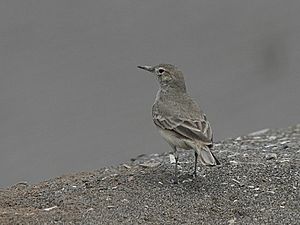Coastal miner facts for kids
Quick facts for kids Coastal miner |
|
|---|---|
 |
|
| Conservation status | |
| Scientific classification | |
| Genus: |
Geositta
|
| Species: |
peruviana
|
 |
|
The coastal miner (Geositta peruviana) is a small bird that lives only in Peru. It's part of a bird group called "miners" and "leaftossers," which are known for digging nests. This bird belongs to the ovenbird family, Furnariidae.
Contents
Meet the Coastal Miner's Family
The coastal miner has three different types, called subspecies. Think of them like different versions of the same bird! They are named G. p. peruviana, G. p. paytae, and G. p. rostrata.
This bird is closely related to other "miner" birds. Its closest cousins are the common miner and the slender-billed miner.
What Does the Coastal Miner Look Like?
The coastal miner is a small bird, about 12 to 14.5 centimeters (5 to 6 inches) long. It weighs around 16 to 19 grams (about half an ounce). Both male and female birds look the same.
Its back is a pale brown color. Some of the subspecies are a lighter sandy brown. The feathers on its tail are a mix of brown, black, and creamy white. When it flies, you can see a buffy band on its wings.
The bird has a pale stripe above its eye, like an eyebrow. Its belly is a creamy white color. It has dark brown eyes, a blue-gray beak with a black tip, and whitish-gray legs.
Where Do Coastal Miners Live?
The coastal miner lives only in Peru. Each of its three subspecies lives in a different part of the country.
- G. p. paytae lives in the northwest, from Tumbes to Ancash.
- The G. p. peruviana subspecies lives in central Peru, from Ancash south to Lima.
- G. p. rostrata is found only in the southwest, in the Department of Ica.
These birds love open, sandy areas along the coast. You can find them from the seaside dunes all the way inland. They live from sea level up to about 700 meters (2,300 feet) high.
Coastal Miner Behavior
How Coastal Miners Move Around
Coastal miners stay in their home areas all year long. They mostly stay on the ground. Sometimes, you might see them perched on low plants or walls.
What Do Coastal Miners Eat?
Scientists don't know much about how coastal miners find food or what they eat exactly. But they probably eat small creatures without backbones, like insects, that live on the ground.
Coastal Miner Nests and Babies
Only one coastal miner nest has ever been found! It was at the end of a tunnel dug into the ground. This special nest had two eggs inside.
What Sounds Do Coastal Miners Make?
Scientists have recorded a few sounds from the coastal miner. When it flies to show off, it sings an "unmusical pjee-aww" sound. It also makes a squeaky "cueet" call.
Is the Coastal Miner in Danger?
The IUCN (International Union for Conservation of Nature) says the coastal miner is a species of "Least Concern." This means it's not currently in danger of disappearing.
It lives in a large area, and even though we don't know exactly how many there are, their numbers seem stable. There are no big threats to this bird right now. Much of its sandy home isn't useful for humans, which helps keep the birds safe.
See also
 In Spanish: Minero peruano para niños
In Spanish: Minero peruano para niños


